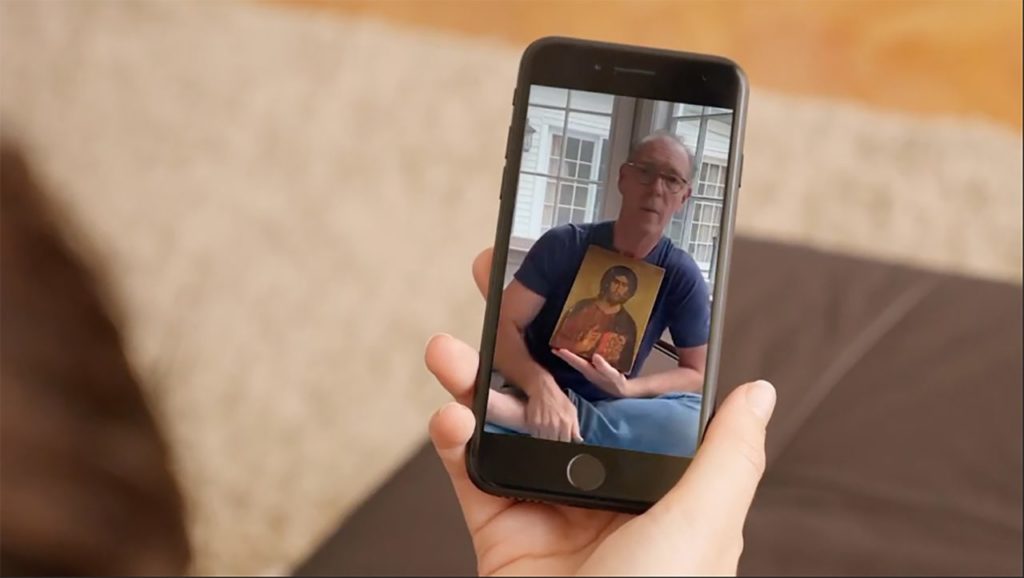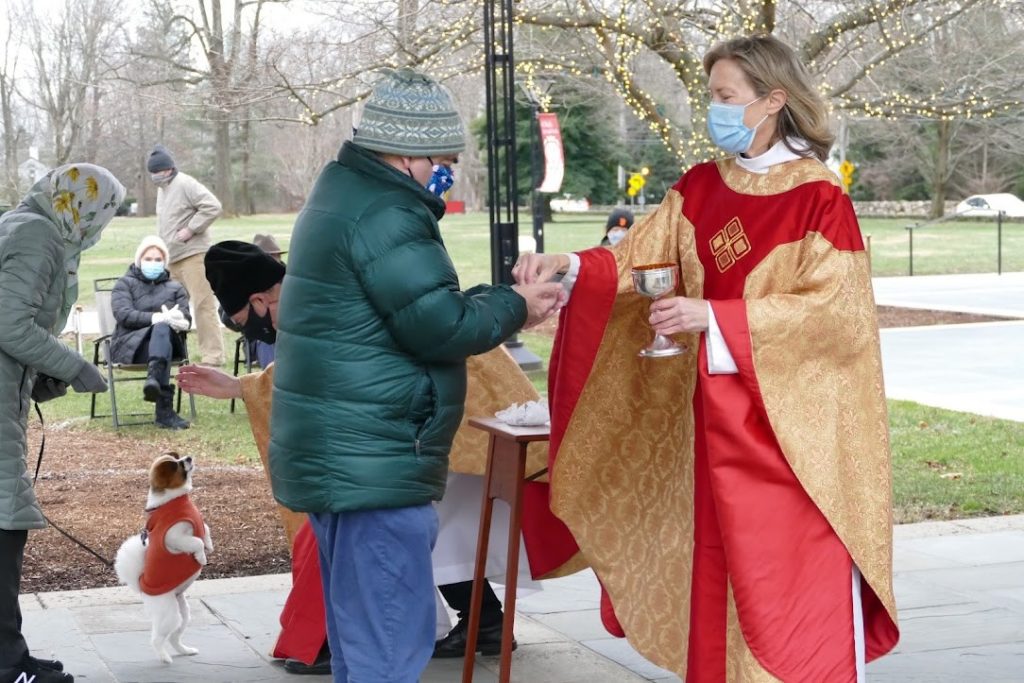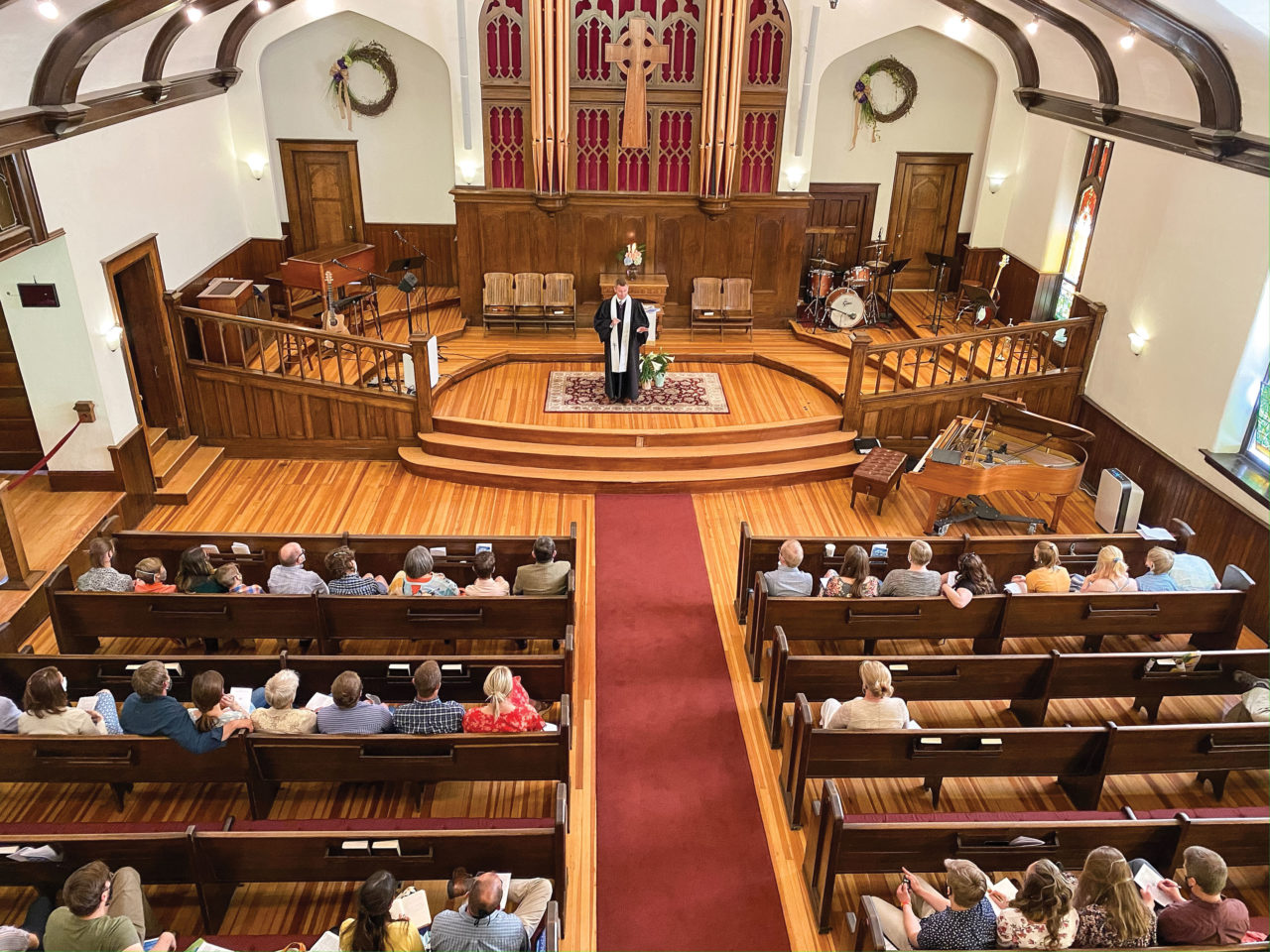By Emily Kemme
When the COVID-19 pandemic hit, faith leaders had to solve a riddle to a unique challenge: How to create a sacred space without walls.
For the faithful, houses of worship are brick-and-mortar safe havens. They are a place for specific religious practices that ascribe to the theology of their religious domination. At the same time, within these walls are venues for connection, for celebrating life’s milestones and where people gather to pay tribute to loved ones. Supported by others, they are a conduit for finding solace and comfort in times of grief.
These spaces are also for gathering to break bread, partly because of religious symbolism associated with certain foods, partly because food as nourishment creates communal and cultural bonds.
For two years now, faith leaders have grappled with how to meet these needs, pulling from deep within themselves and facing their own fears to help their followers find meaning in a topsy-turvy world.

Fr. Peter Walsh uses technology to connect with his St. Mark’s Episcopal Church parishioners during the COVID-19 pandemic. Photo courtesy of St. Mark’s Episcopal Church.
The challenge of staying connected
Human connection is fundamental for wellness, says Fort Collins family therapist Susan Bolint. She defines spirituality as a connection to something larger than you. Some source spirituality in ways not defined by institutional worship standards; they may seek it outside in nature or through contemplation.
“Without connection, we lose the ability to thrive. We’re wired for it; when we’re separated from each other it stresses us,” she says. “There’s an inner search for meaning; that’s my purpose of being a therapist.”
Reverend Elizabeth Garnsey, a Greeley native who is Associate Rector at St. Mark’s Episcopal Church in New Canaan, Conn., says the word “religion” is rooted in the Latin word, “ligament.”
When doors to the church closed, Garnsey reminded her congregation how historically, in times of suffering, people drew together to face common fears.
“Our practices are meant to connect us as a community to acknowledge the greater source,” she says.
But enforced isolation made togetherness complicated. Before the pandemic, Rabbi Sara Gilbert of Beth Israel Congregation in Greeley was slightly familiar with Zoom. As her congregation began to isolate, staying connected to her predominantly middle-aged and older congregants and adapting them to technology was Gilbert’s first obstacle.
As her followers learned new skills, she knew who she saw on-screen regularly for Shabbat services, but also missed others who lost touch. Phone calls helped bring those who weren’t technologically savvy up to speed, but two years into the pandemic, people say they are tired of sitting in front of a screen.
Even Garnsey’s large congregation of 550 households, with three clergy looking after people, struggled to find the right balance.
“We were already streaming, but the challenge was adjusting the liturgy to make it look good,” Garnsey says. “Before it was more voyeuristic: they can look at us. Now we are part of the congregation.”
For St. Mark’s, that meant adding a popular outdoor service in July 2020. After 87 weeks of meeting in all weathers, it’s still offered, along with two indoor services and live streaming to accommodate those still uncomfortable about coming inside. Their organist coordinated members from their homes, conducting a Zoom choir that synced and unified individual voices.
Gilbert added new programming, including a weekly Havdalah service to mark the close of the Jewish Sabbath.
In April 2020, Gilbert’s congregation held a virtual Passover seder, taking advantage of the coincidental timing to discuss the pandemic as one of the ten Biblical plagues. The holiday is a time when symbolic foods are eaten to tell the story of the Jews’ exodus from Egypt.
“We decided the pandemic wasn’t a punishment or plague like the Passover story, but a reason for us to examine how we’re dealing with the environment, health care system and our fellow human beings throughout the world,” she says.

Reverend Elizabeth Garnsey giving parishioners communion during chilly outdoor services at St. Mark’s Episcopal Church, New Canaan, Conn. Photo courtesy of St. Mark’s Episcopal Church.
Food as a cultural connection
Michael Mathews, lead pastor at Saint Patrick Presbyterian in Greeley, took his congregation online from the middle of March 2020 through the end of June, offering hybrid services with both virtual and reduced occupancy thereafter. Although connecting with his congregation improved at every phase of the pandemic, he finds counseling parishioners frustrating because it’s harder to schedule meetings.
“You don’t know who’s comfortable going out for coffee, so it’s tougher to know where people are individually,” Mathews says. “It’s getting better but we’re still in that place.”
He believes the disembodied tragedy of the pandemic reinforces the importance of community, which more than anything means having real friends: people who care about you who will go out and get you groceries if you need it.
“Early on, it was enough to reach out by phone and let people know they were being taken care of,” Mathews says. “Taking someone groceries was as or more important than checking on anxiety or depression.”
Appreciating what we have
Mathews believes it’s possible to account for what we’ve lost and begin healing if we can recapture grace, defining it both in religious terms and in reconnecting with each other with a sense of thankfulness and gratitude.
“We need to remember what we’ve been given by God—to remember those times in the last two years where people have been gracious, kind, where they’ve sacrificed for us,” Mathews says. “That includes tallying blessings in the midst of loss. For a long time, I had seven people sitting around the dinner table; it’s not something that happens when you have three high-schoolers.”
Two years into the pandemic, Gilbert feels a measure of accomplishment. Her congregation has stayed in touch, supported each other and they made new connections, even those who didn’t think they had anything in common. There are still differing opinions over whether to continue virtual services or gather in person; differences in vaccination status have created more schisms in the close-knit community.
But until her synagogue can share a meal together again at the conclusion of worship services, she says it’s not going to feel normal.






